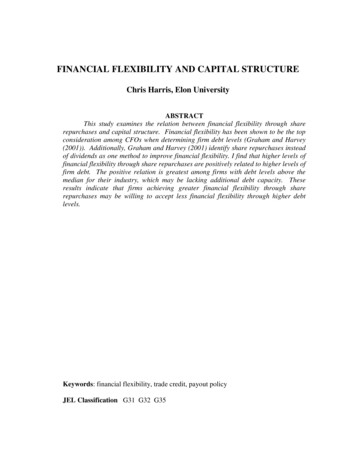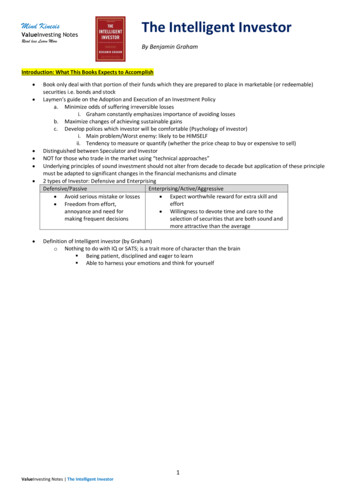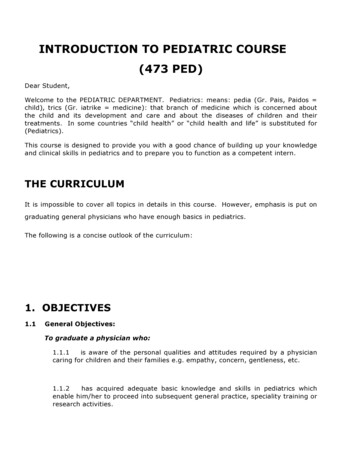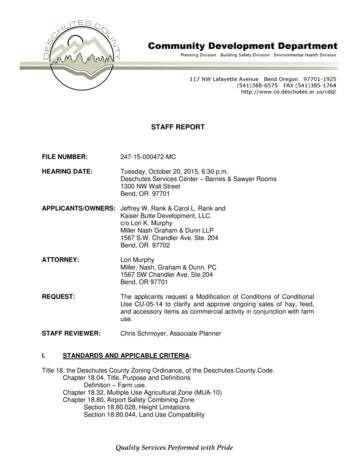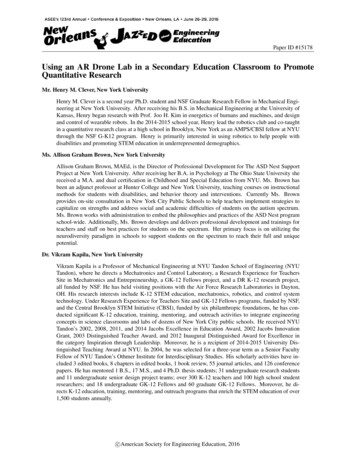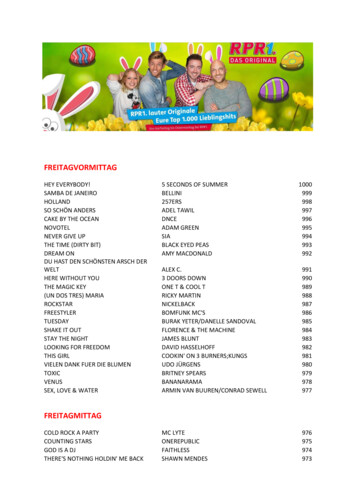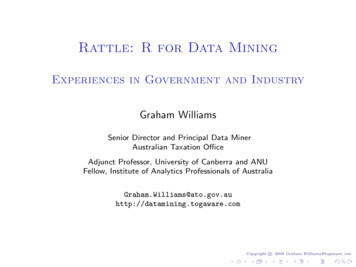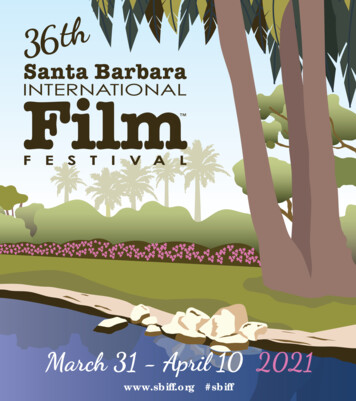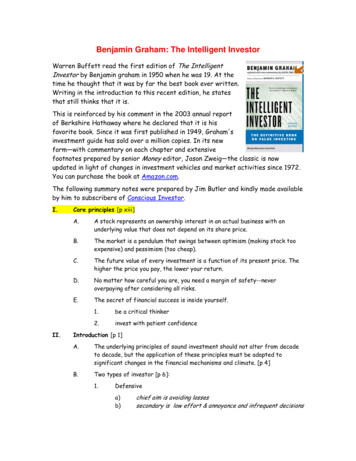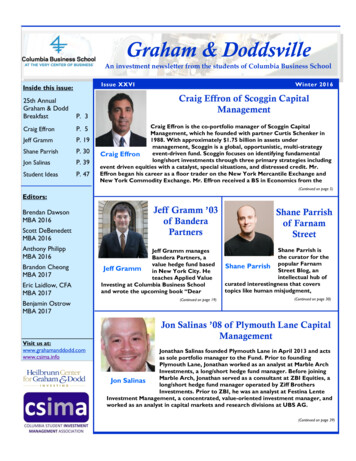
Transcription
Graham & DoddsvilleAn investment newsletter from the students of Columbia Business SchoolIssue XXVIInside this issue:25th AnnualGraham & DoddBreakfastP. 3Craig EffronP. 5Jeff GrammP. 19Shane ParrishP. 30Jon SalinasP. 39Student IdeasP. 47Winter 2016Craig Effron of Scoggin CapitalManagementCraig Effron is the co-portfolio manager of Scoggin CapitalManagement, which he founded with partner Curtis Schenker in1988. With approximately 1.75 billion in assets undermanagement, Scoggin is a global, opportunistic, multi-strategyevent-driven fund. Scoggin focuses on identifying fundamentalCraig Effronlong/short investments through three primary strategies includingevent driven equities with a catalyst, special situations, and distressed credit. Mr.Effron began his career as a floor trader on the New York Mercantile Exchange andNew York Commodity Exchange. Mr. Effron received a BS in Economics from the(Continued on page 5)Editors:Brendan DawsonMBA 2016Scott DeBenedettMBA 2016Anthony PhilippMBA 2016Brandon CheongMBA 2017Eric Laidlow, CFAMBA 2017Benjamin OstrowMBA 2017Visit us at:www.grahamanddodd.comwww.csima.infoJeff Gramm ’03of BanderaPartnersJeff Gramm managesBandera Partners, avalue hedge fund basedJeff Grammin New York City. Heteaches Applied ValueInvesting at Columbia Business Schooland wrote the upcoming book “Dear(Continued on page 19)Shane Parrishof FarnamStreetShane Parrish isthe curator for theShane Parrish popular FarnamStreet Blog, anintellectual hub ofcurated interestingness that coverstopics like human misjudgment,(Continued on page 30)Jon Salinas ’08 of Plymouth Lane CapitalManagementJonathan Salinas founded RolfPlymouthLane in April 2013 and actsHeitmeyeras sole portfolio manager to the Fund. Prior to foundingPlymouth Lane, Jonathan worked as an analyst at Marble ArchInvestments, a long/short hedge fund manager. Before joiningMarble Arch, Jonathan served as a consultant at ZBI Equities, aJon Salinaslong/short hedge fund manager operated by Ziff BrothersInvestments. Prior to ZBI, he was an analyst at Festina LenteInvestment Management, a concentrated, value-oriented investment manager, andworked as an analyst in capital markets and research divisions at UBS AG.(Continued on page 39)
Page 2Welcome to Graham & DoddsvilleWe are pleased to bring you the26th edition of Graham &Doddsville. This student-led investment publication of Columbia Business School (CBS) is cosponsored by the HeilbrunnCenter for Graham & DoddInvesting and the Columbia Student Investment ManagementAssociation (CSIMA).Meredith Trivedi, theHeilbrunn Center Director.Meredith skillfully leads theCenter, cultivating strongrelationships with some ofthe world’s most experienced value investors, andcreating numerous learningopportunities for studentsinterested in value investing. The classes sponsoredby the Heilbrunn Centerare among the most heavilydemanded and highly ratedclasses at Columbia Business School.In this issue, we were fortunateto speak with three investorsand the founder of the popularblog Farnam Street.Craig Effron of Scoggin CapitalManagement discusses the evolution of his firm and his investment approach from commodities to the stock market. Craigoffers insights into his risk management mentality, challengesfacing the investment management community, and creativeways to express investmenttheses while managing againstdownside risk. He shares recentcase studies in the event-drivenspace and opportunities he currently see in distressed creditsin Puerto Rico and energy.Jeff Gramm ’03 of BanderaPartners discusses his book onactivism “Dear Chairman:Boardroom Battles and the Riseof Shareholder Activism” andwalks through current ideasincluding Famous Dave’s(DAVE) and Star Gas Part-ners (SGU).Shane Parrish discusses theorigination of Farnam Streetand his focus on becoming abetter learner, as epitomizedby Warren Buffett and CharlieMunger. Shane explains howthese learnings apply to becoming a better investor and shareshis hopes for Farnam Streetand its readership.Jonathan Salinas ’08 of Plymouth Lane Capital discusses hisexperiences with varied investment approaches and mentorsand how his background leading up to founding PlymouthLane has contributed to thefirm’s world view and how heseeks to invest. Jonathan alsoshares current ideas DHXMedia (DHXM) and SequentialBrands Group (SQBG).This issue also highlights photos from the 25th Annual Graham & Dodd Breakfast, held onOctober 9th, 2015 at thePierre Hotel in New York. Thisevent brings together alumni,students, scholars, and practitioners for a forum on currentinsights and approaches toinvesting. This year’s breakfastfeatured a conversation withPhilippe Laffont of Coatue Management moderated by Professor Bruce Greenwald of Columbia Business School.Lastly, we are proud to bringyou pitches from current students at CBS. We feature finalists from the Darden at VirginiaInvesting Competition, Columbia Business School’s inauguralCSIMA Stock Pitch Challenge,and Alpha Challenge at UNCKenan-Flagler.The three finalist ideas fromour classmates include: MarcGrow ’17, Benjamin Ostrow’17, and Evan Zehnal ’17 —Dexcom Inc. (DXCM) Short;Nielsen Fields ’17, Joanna Vu’17, and Adam Xiao ’17 —Quest Diagnostics (DGX)Short; and Justin Hong ’17,Zachary Rieger ’17, and Cristóbal Silva ’17 — XPO Logistics(XPO) Long.As always, we thank ourinterviewees for contributingtheir time and insights not onlyto us, but to the investmentcommunity as a whole, and wethank you for reading.- G&Dsville EditorsProfessor Bruce Greenwald,the Faculty Co-Director ofthe Heilbrunn Center. TheCenter sponsors the ValueInvesting Program, a rigorous academic curriculum forparticularly committed students that is taught by someof the industry’s best practitioners.Keynote speaker Philippe Laffontaddresses attendees at the 25th AnnualGraham & Dodd BreakfastAttendees gather at the 25th AnnualGraham & Dodd Breakfast
Volume I, Issue 2Page 325th Annual Graham & Dodd Breakfast—October 9, 2015 at The Pierre HotelMario Gabelli ’67 at the Graham & Dodd Breakfast withkeynote speaker Philippe LaffontProfessor Bruce Greenwald with Philippe Laffont at theGraham & Dodd BreakfastSid and Helaine Lerner speak with Heilbrunn advisoryboard member Tom RussoHeilbrunn advisory board members David Greenspan ’00,William von Mueffling ’95, and Jenny Wallace ’94
Page 4SAVE THE DATE FOR THE 7th ANNUAL“From Graham to Buffettand Beyond” DinnerFriday, April 29, 20166 p.m. to 9 p.m.The Omaha Hilton1001 Cass Street Omaha, NebraskaTickets will go on sale in March atwww.grahamanddodd.com
Page 5Craig Effron(Continued from page 1)Wharton School ofBusiness of the Universityof Pennsylvania.Graham & Doddsville(G&D): Could you tell usabout your background andhow you came to investing?Craig EffronCraig Effron (CE): It’simportant, because I am notthe traditional hedge fundstory. I didn’t work two yearsin investment banking and thengo to Harvard Business School.I went to Wharton forundergrad. I did not get intoNYU Law, but I got into Duke.I went down to Duke for aweekend with my parents andeverybody there was 6'4” andblonde. I said, "I'm not going todo very well here. Socially, Icannot go here." My parentssaid, "I tell you what, take ayear off, defer, and thenreapply to NYU a year laterand hopefully get in.”During that year, I met up withtwo buddies for a card game atPenn. They were playing forstakes that I had never evenknown existed. I said, "Whatdo you guys do for a living?"One said, "We tradecommodities. On the floor, webuy and sell gold and silver. It'sreally fun and you should comecheck it out."I had been working at EFHutton, which was big ineverything, but they wentbankrupt in the ’80s. I hadgotten a job there right afterschool and worked there for afew months. But, then I playedin this card game and,afterward, went down to thefloor with my friends. Ithought, "Wow, this looks likea lot of fun." Somehow, Iconvinced my parents to lendme forty thousand dollars totry my hand at tradingcommodities. I said that if Ididn't do well, I would go tolaw school a year later. I didwell. I learned a lot about lifeand about commodities andtrading. And I was fairly goodat it.The problem withcommodities trading is that itends at 2:30 in the afternoon.When you’re 24 years old youcan get into a lot of trouble ifyou’re done at 2:30pm unlessyou have something to do. Idecided to start learning thestock market. I had gone toWharton for undergrad andsomewhat thought I knewwhat I was doing, but I didn’treally know how to invest.About five years into tradingon the COMEX, I starteddoing risk arbitrage.That was the heyday of MikeMilken. I thought I was a geniusbecause every time there wasa deal announced,automatically—within aweek—there would be atopping bid. Then there wouldbe a third bid; it was crazy.Everyone on the floor knewabout my success tradingstocks. They all gave me theirmoney, as my friends, to runfor free. I did that for a yearand it was fun. I had about 30accounts and I was doing it forfree.Paul Tudor Jones, who stoodnext to me in the ring, was agood buddy of mine and said,"You know what? Run mymoney, as well. But one caveat:I want you to charge me a fee."I asked, "Why do you want meto charge you a fee?" And,being as smart as Paul is, hesaid, “Because if you charge mea fee, you will pay attention tomy account first.” He was deadright.After about a year of managingPaul’s money and these otheraccounts, I realized that I likeddoing this more than tradingcommodities. I left and toldeverybody I was going to puttogether a fund called Scogginwith my partner CurtisSchenker, who is still mypartner.Here’s a key element of ourpartnership and how Curtisand I complement eachother—it’s an important factabout Scoggin. Curtis was mybest friend before we startedScoggin. He’s my best friendstill. Curtis and I keep eachother grounded. We realizewe caught a 30 year bullmarket. We weren't thatsmart. We happened to havemoney under management, andit worked out. Curtis and Idon't take ourselves tooseriously. He has always beenMr. Naysayer, and I'm Mr. It’sAlways-Bullish.He’s the guy who kept us inbusiness a lot because Iwould've been a lot moreaggressive during thetechnology bubble. He said,“Craig, leave it alone. This isnot what we do. We don’tknow what that means. We’renot doing that.” And of courselater technology blows up.That’s why it works, and that’swhy we’re still best friends andstill partners.Part of this Scoggin charm, ifyou want to call it that, is thatwe still are friends first andpartners second. I think it sortof flows through the wholeoffice. The average tenure ofmy analysts here is 10 to 12years. There are a few newguys who are two or three(Continued on page 6)
Page 6Craig Effronyears but basically I have 12analysts, and six or eight ofthem have been here sincebefore 2000. It’s a very nicefeeling to know that I can goon vacation and know that I’mnot going to have someoneblow me up.Incidentally, the name“Scoggin” comes from a campthat Curtis and I went to inMaine. I met him there and wereunited at Penn. We startedScoggin together with these 30accounts, Curtis’s money, andmy money. It was about 3million in total and that washow we started in 1988. Toput it in perspective, as ahedge fund with 3 million in1988, we were not even thesmallest, while the biggest fundwas about 80 million.G&D: At that point, were youjust focused on risk arbitrage?CE: Yes, that's all we weredoing at that point. We wereup a lot of money in ’89 and inSeptember of ’89 the biggestdeal in history was UnitedAirlines. The deal blew up andeverybody in my world wentout of business. We went fromup 65% to up 20%, which is abig draw down, but still up20%. Before this, I had beencompeting to attract the besttalent, but I couldn’t afford tohire many of them. Now, theywere working for free becausethey were all out of work. Ihired a restructuring analyst, along/short analyst, and otherswhom I could never haveafforded before that.That is when Scoggin wasreally born because we couldnow do things besides just getlucky with Mike Milken doingtopping bids. We could still dorisk arbitrage, but now wecould get involved in distressedcredit, spin-offs, andrestructuring—anything thathas an event. We went fromrunning 3 million to running 3 billion by the late 2000s.We sort of stopped raisingmoney because I liked my lifeand I didn't want to be amanager of people; I wanted tobe a manager of money. And,mostly, I wanted it to be myown money.Then ’08 happened. We hadno losing years until 2008. Wehad twenty years where everyyear we made money. At thatpoint we were up 17.5% net toinvestors. 2008 occurs and,“I realized howfleeting success can bein a market, whetherit’s a stock market or acommodities market.My whole perspectiveon investing has been,and hopefully willcontinue to be, not tolose.”depending on which fund youlook at, we lost between 20%and 30%. To my investors, Iwas known as a “Jewish T-bill.”This is a very bad thing to beknown as—not the “Jewish”part but the “T-bill” part.Because when you then have alosing year, they say, "Oh myGod, it's not a T-bill." Thenthey start to realize, "Wait aminute, he's got risk after all.We thought you were reallysafe. We thought you couldn'tlose.” I had to go through thiswhole process for myinvestors explaining why theyshouldn't pull their money out.A lot of them did a year later.We blew up after redemptiondates so the investors had towait to redeem. We mademost of the money back in2009, but they were all sostunned about what hadhappened that we lost about25% of our capital throughredemptions in 2009. That wasa learning experience for me.You don't ever want to havepeople think you are what youare not. Then the Madoff thinghappened the same year, sothey started saying, "Wait aminute. Madoff didn’t losemoney for 20 years either." Iactually had to explain why I'mnot Madoff to my big investors.They knew I wasn’t, yet theyhad to check the boxes tomake sure I wasn't actuallyMadoff.G&D: Were they institutions?CE: Yes, they’re my big guys,and they were worried thatthey were going to be firedfrom their jobs. Imagine havinganother fraud that youinvested in. A lot of institutionswere invested with Madoff.The reality is that a lot of thefund is my money and Curtis’smoney. If you do the math, wecan do much better makinggood returns on our ownmoney than with managementfees. Except, this year we arelosing money. It’s the secondtime we’re losing money since2008. We are down about10%. It's really nauseatingbecause we have done a goodjob to be down 10%—that’swhat’s scary. We’ve done veryfew things wrong, but thosethings we have done wrong(Continued on page 7)
Page 7Craig Effronhave been fatal in 2015.G&D: Could you talk abouthow you think about managingthe downside in yourportfolio?Matthew Baredes ’17,Matheus Romariz ’16, andNicholas Turchetta ’17volunteer at the Graham &Dodd BreakfastCE: Let’s go back to the floorexperience. Managers you’vespoken to in the past and withwhom you will speak in thefuture are probably “traditionalanalysts.” They come fromgood schools, they learn atMorgan Stanley or CenterviewPartners how to be an analyst.They start becoming investorsand that’s their thing. I amtotally different. I am a trader. Iam a risk manager. I was verysuccessful on the floor becauseI didn't go out of business.I remember when I was 23 or24, there were the “MichaelJordans” and the “TomBradys” of the floor. Theywere famous. They were thebig traders who tradedhundreds of lots. I’m there forabout six to nine months andI’m a little baby trader at thispoint. I get tapped on theshoulder by a veteran trader.He was one of the biggesttraders in gold. He taps me onthe shoulder one day and says,"Hey, can I talk to you? I'mwondering if I could borrowsome money from you. I had alittle problem: I was shortgold." Gold went crazy and hewent out of business.I said, "I don't have any moneyto lend you—I'm 23 yearsold—but I appreciate thatthought." I said to myself,"Wow this guy was amillionaire." He was lookingfor money because he wentout of business. I realized howfleeting success can be in amarket, whether it’s a stockmarket or a commoditiesmarket. My whole perspectiveon investing has been, andhopefully will continue to be,not to lose.Relatively speaking, makingmoney is easy. It’s avoidinglosing that’s important andmuch more difficult. This 10%down year is going to cost metwo years of money. I can tellyou next year will be a very“I’ve learned thatpeople tend to giveyou a one-year graceperiod. They realizethat the S&P is flat forthe year but the realmarket is not. Thereare 327 stocks downthis year out of 500 inthe S&P with ahandfuloutperforming.”difficult year as well. In fact, ifwe fight back to even in twoyears I will be happy. The keyto our business, I’ve learned, isthis: don't go down. It’s fatal toa lot of firms. The average ageof a hedge fund that goes outof business is seven years.We're on our 27th year. That’snot by accident. We had 20years of never losing. We had2008, we also lost 3% in 2011,and now this year: three losingyears out of 27. That's howyou stay in business.A lot of very good investorshave blown up. Some havecome back from it, but nottypically. You’re given onechance to go out of businessand that’s it in our industry.You can't redo it. 2008 wasdifferent. People gave you afree pass in 2008. Otherwise, ifyou lose money of any realsize, you’re out of businesspretty quickly. There’s anothersmart guy down the streetwho has done really well andhe will take your money.G&D: How much morecompetitive is the hedge fundindustry now compared withwhen you started?CE: Here is a crazy stat: whenI started business there were300 hedge funds in the world.There are now over 10,000.We were the 165th biggest in1990 with maybe 30 million,155th in 2000 at around 1billion, and we were 177th in2008 at 3 billion. No matterhow big we got, we never gotany bigger relatively. It’ssymptomatic of the issueswe’re having now in ourbusiness. There’s too muchmoney in it.The business was an amazingbusiness when no one knewwhat it was. In my world, atyour age, mediocrity in mybusiness made you verywealthy. People wanted to beinvested in hedge funds. Theydidn't care if you were thebest. They wanted to be in ahedge fund; that was the coolthing to be in the ’90s. If youwere just mediocre, making 8%a year, people were delightedbecause they were doing it in ahedge fund as opposed todoing it in a mutual fund. Nowyou're in a position where it’snot good to be a hedge fundunless you're really good at it.(Continued on page 8)
Page 8Craig EffronPeople that were terrible weremaking tons of money onmanagement fees. That allchanged in 2008; they wentout of business. Now, in ourbusiness, if you’re not in thetop 20%, you don't make anymoney, and that’s the way itshould be. Like any business,you should be required to bein the top percentile ofperformers to remain inbusiness. That's the newdynamic, the new normal in myworld. If you aren't good at it,you actually are out ofbusiness. Every year, I’ve gotto be good again because thereare many options out there.Whether it’s another hedgefund or a quant fund, there areso many options that peoplesay, "Look, we love you as aperson, but you’re making nomoney for me."Now for 2015, we are downbetween 10% and 11% at thispoint, and we have had veryfew redemptions. I’ve learnedthat people tend to give you aone-year grace period. Theyrealize that the S&P is flat forthe year but the real market isnot. There are 327 stocksdown this year out of 500 inthe S&P with a handfuloutperforming.G&D: Those are companieslike Google and Amazon?CE: Out of those stocks thatare up, it’s about six that makea difference. That's not what Ido. I don't trade Google(GOOG) and Amazon(AMZN). If I did, I wouldn'tneed to be in this business. I’mdoing things that are "tricky”or “clever,” and not so muchthis year, obviously. It’s notjust me. Because, as you know,my world is getting destroyed.We are trading on events thattheoretically have catalysts,and that has been a horriblebusiness this year.G&D: Did the catalysts notcome through or did thecatalysts not matter much?CE: Some didn’t comethrough and some camethrough and ended up with badresults. I’ll give you a case inpoint which I find amazing.Starwood Hotels (HOT) wentup for sale in June. The stockat the time was at 80/share.Everybody had a break-upvalue of somewhere between 90 and 105. On June 15th,when Starwood announcedthat the company was up forsale, the stock was up a littlebit that day. Then the market“There are a lot ofthings out there thatare scaring me. But,I’m paid to play, andthat’s what I do. But Idon’t play withleverage.”blew up and the stock wasdown into the 60s. By thetime the market came backabout a month later, the stockwas at 75.In the first week of Novembermanagement announced therewere three buyers. One is aChinese buyer who owns TheWaldorf; one is Hyatt Hotels(H); and one was anundisclosed name. The stockgoes from 75 to 78 becauseit’s going to be an awfully gooddeal. Five days later theyannounce a deal with Marriott(MAR) at 70: a take-under. Ihad not seen that in 25 years.Now obviously there’s moreto the story. Maybe it’sbecause something is going onin the company that I don'tknow about. We thought,“There are three buyers. Weare going to make a lot ofmoney." We lost 10%overnight on that trade. That'sjust one example of what isgoing on this year.Also, Mylan (MYL) was tryingto buy Perrigo (PRGO) thisyear. It was a big deal. Mylancame in hostilely and Perrigohad no defenses. They wentdown to the last week, wherethey needed 50.1% of thevotes to vote “yes” for thedeal from Mylan. If you vote“yes,” you make 20; it’s thatsimple. If you vote “no,” thestock will go down and youlose 15. There's a 35differential. In the history ofthe world, I've never seenpeople vote without theirpocketbooks underconsideration. Not only did itnot go through, but also thedeal lost by a lot.What I learned was thatpeople like making money, butthere are things they likemore. In this case, they likedthe CEO of Perrigo so muchthat they felt badly for him.They said, "Let this guy try tomake it." They hated Mylan'sguy. I’m not saying I loved him,but he was offering me 20more than where the stockwas trading. They chose not totake the 20 and lose 15instead. I thought it was a nobrainer. It was the biggestposition on the street andpeople got destroyed. Who(Continued on page 9)
Page 9Craig Effronwould think that people wouldthrow off 20 and take a 15loss? But, that’s what we’rereading now.G&D: Did they think therewould be additional bidders?CE: No, we were already pastthat. We thought initially therewould be. Now it is the lastday; it’s over. Either you takethe 20 or you table it. In allmy years doing this business,I’ve never seen people not takethe money. It was a bigdifference. Not like it was a 2premium. It was 20 on a 140stock. When things like thathappen in my world, it’s hardto make money. I’d make thatbet every day of my life. It’sjust how it goes.G&D: Do you know anythingabout the make-up of thevotes?CE: It was every arbitrageur,representing about 25% of thefloat. They voted “yes,”obviously. The indexers endedup voting “yes,” which hadbeen a big issue. When I heardthe indexers were going to bevoting “yes,” I said, "This isgoing to be a no-brainer."Every plain vanilla or Fidelity ofthe world had a one-on-onewith the CEO on thatThursday of the vote. And thatguy pleaded. He said, "Guys,you are going to end upowning Mylan stock. He’s acriminal; he does terriblethings. Perrigo has real brands.Give me a year to make this upto you. Just give me that yearand, if I don’t do something inthat year, I’ll get anotherbuyer." They bought into it. Allthe institutions, which are themain voters, all voted his way,and all turned on the daybefore the vote. We all hadthought they would take themoney, because everyonetakes the money.That’s what I’m dealing withthis year. The events space hasbeen a disaster, an unequivocaldisaster. Unless you’re longAmazon and Netflix (NFLX)and the Jim Cramer FANGstocks, you’re having a reallylousy year. If you’re an energyrelated guy, you’re out ofbusiness. Things are bad inretail, too. Macy’s (M) is thegold standard and it is down50% this year. Hospitals andHMOs were obliterated thelast two months, I don't knowwhy. If you’re in the wrongsectors, you think it is a bearmarket like 2008 versus themarket being very quietly up1%.“‘Don’t be so bigwhere your eyes arebleeding and you’vegot to get out. Sizeyour positions so thatyou can withstandwhat happens if youfriends, and they’re brilliantguys, who have four or fivetimes leverage now, and Ialways wonder, "How do theysleep at night?" If, God forbid,something happens out of theblue, the next day they’relosing something like 15% or20%. But look, that’s how theywere brought up. I wasbrought up a different waybecause I was a commoditiestrader where leverage was abad thing. You could get blownaway by being too big.For the last five years, it hasbeen fine because the Fed hadyour back. It's been a very easymarket until this year. Oncethe Fed stopped QE themarket became difficult. Sowhat it really shows is thatmost of us have just beengliding along because of the QEwind at our backs. And nowthat QE’s done, that’s why themarket has been flat. QE isover and now we have theprospect of higher rates. Thereare a lot of things out therethat are scaring me. But, I'mpaid to play, and that’s what Ido. But I don’t play withleverage. Now, we do use amodicum of leverage, maybe120% gross, but not 300%gross.are wrong.”G&D: Could you go into a bitmore detail?G&D: You don’t use a lot ofleverage. Was that a productof 2008 or have you alwaysbeen more conservative?CE: Our average exposure isabout 120%. Our net is about45% long. That's where weusually run. We go as low as80% gross and 20% long.We’re always long. You guysshould know one thing: themarkets go up over time.That's just how it is. If you tryto play the short game at thewrong time, you'll lose money.CE: No, it was a product ofme being on the trading floorand realizing what can happen.Leverage is a two-edgedsword. It’s wonderful when thetrade is going up, but you’reout of business quickly when itgoes the other way. I haveYou don’t want to be short(Continued on page 10)
Page 10Craig Effronmarkets over a long period oftime. We all watched the tenyear period from 2000 to2010. That was a flat period. Ihad never seen that before.Remember, I saw giganticperiods. The ’90s grew ataround 20% a year, the ’80saveraged 10% or 15% a year.So 2000 to 2010 was aninteresting period. But, yes,we're low-leverage guys.G&D: Building on the topic ofrisk management, let’sconsider a situation likePerrigo where what youthought would happen did notoccur. Can you talk about howyou think about the nextsteps?CE: I’ve learned over my manyyears doing this that you neversell the first day of a bad event.That is for amateurs becausethere are guys that are so bigthat their eyes are bleedingand they have to get out. If youlook at where the stock is onday one versus day 30, 99% ofthe time every sale you madewas bad. You wait a month andthen you can reassess. Perrigois no different. Perrigo openedat 135. I closed my eyes, Ididn't do a thing. It's now 150. Now we're getting out.We made our 15 back. Sonow we broke even on thetrade, but we lost the 20 wewould have made.People that sold on day oneand day two and three, arekicking themselves. Last year,AbbVie blew up the big dealwith Shire. Shire went down 100. If you waited one year, itwas higher than the bid.G&D: Is that because of thetax inversion?CE: That’s what it was—it wasthe tax inversion. It wasbecause AbbVie was scared ofgetting yelled at by Obama. Sothey blew it up. They tradedfrom 250 to 150. Settledaround 180 for the next twoor three months, then wentback to 260. Now it’s back to 220. What we have learnedhere is, “Don't be so big whereyour eyes are bleeding andyou’ve got to get out.” Sizeyour positions so that you canwithstand what happens if youare wrong. In Perrigo, we onlylost 50 basis points on thatbreak, because I knew I didn’twant to be selling it badly.Normally, if we’d been up forthe year we probably wouldhave risked 1.5% on that trade,that’s how good I thought itwas. It was an overnight binarybet. That is not a big bet if itwas 1.5%. But it is when you’remaking a bet on red or black.G&D: How concentrated areyour positions?CE: We have about 20, maybe30, positions, and our biggestare between 5% and 7%. Wehave nothing smaller than 1.5%or 2%, and we averageprobably 4%. We’re veryfocused on protecting againstthe downside, and that drivesour risk management approachand portfolio construction.People have this view of hedgefund guys, that they are likemagicians and that there isvoodoo going on. There is novoodoo. You guys are as goodas I am at this. Your opinion isas valid as mine is. I’ve beendoing it longer; that is thedifference. I’ve seen theexamples of ideas from yourclasses. There are brilliantpeople. My analysts are not anymore brilliant than you; theyjust have experience doing it.What students miss a lot is thepractical matter of the stock.For some of the short ideas, Iask, “Do you realize the shortinterest in this thing?” Theyrealize there's not just adownside of losing X amountin an upside case. When youand the whole world are shorta stock, you go out of businesstoo many times. People yourage often don't understandtechnical aspects of themarket. They understand thata stock is not worth 20—it’sonly worth 10. Okay, thatdoesn't mean it’s going to 10.It could go to 50 before itgoes to 10 and does thatmean you made a gooddecision or not?Some people will say ininterviews that their best ideawas long Apple. I ask, “Ok,when did you buy it and forwhat price did you buy it? Ok, 220. Did it go up or downfirst?” They usually say, “Well,it went down first.” I say, “Oh,okay. Where did it go to?” Ifhe says, “To 85 or 90,” thatguy is not getting hiredbecause he thinks t
Shane Parrish P. 30 Jon Salinas P. 39 Student Ideas P. 47 Visit us at: www.grahamanddodd.com www.csima.info Graham & Doddsville An investment newsletter from the students of Columbia Business School Craig Effron of Scoggin Capital Management Shane Parrish is the curator f
